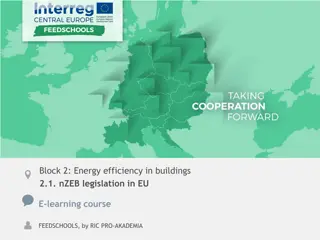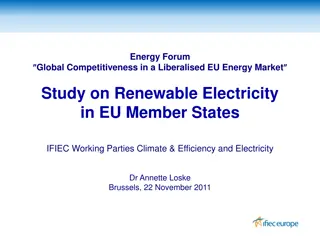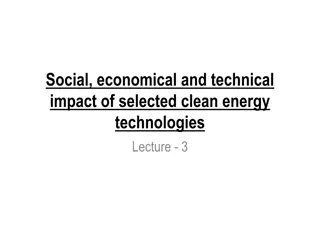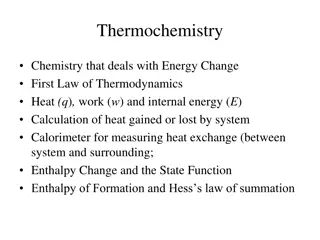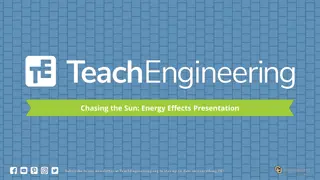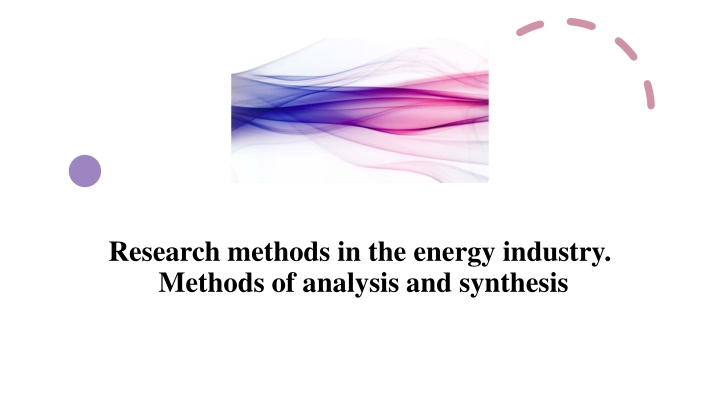
Energy Industry Research Methods and Analysis
Explore various research methods in the energy industry, such as qualitative, quantitative, experimental, and analytical approaches. Learn about the importance of research in advancing renewable energy, improving energy efficiency, mitigating climate change, and more. Dive into methods like data analytics, statistical modeling, simulation models, and field research to drive innovation and sustainability in the energy sector.
Download Presentation

Please find below an Image/Link to download the presentation.
The content on the website is provided AS IS for your information and personal use only. It may not be sold, licensed, or shared on other websites without obtaining consent from the author. If you encounter any issues during the download, it is possible that the publisher has removed the file from their server.
You are allowed to download the files provided on this website for personal or commercial use, subject to the condition that they are used lawfully. All files are the property of their respective owners.
The content on the website is provided AS IS for your information and personal use only. It may not be sold, licensed, or shared on other websites without obtaining consent from the author.
E N D
Presentation Transcript
Research methods in the energy industry. Methods of analysis and synthesis
Introduction to Research in the Energy Industry Why Research is Crucial: Advancing Renewable Energy: Development of solar, wind, bioenergy, and other renewable sources. Improving Energy Efficiency: Innovations in appliances, smart grids, and buildings to reduce consumption. Climate Change Mitigation: Reducing emissions through clean technologies and carbon capture. Energy Storage Solutions: Enhancing reliability of intermittent renewable energy sources (e.g., batteries, hydrogen storage). Grid Modernization: Creating flexible, resilient smart grids for better integration of renewable energy. Economic Growth & Job Creation: Fostering innovation, creating new industries, and boosting the economy. Global Energy Access: Expanding affordable energy to underserved regions through off-grid solutions. Reducing Fossil Fuel Dependence: Advancing alternatives to secure energy independence and stability. Public Health & Environmental Benefits: Reducing pollution and improving air quality for healthier communities.
Types of Research Methods Qualitative Research: Involves understanding perspectives, behaviors, and motivations. (e.g., case studies, interviews) Quantitative Research: Focuses on numerical data and statistical analysis. (e.g., surveys, modeling, experiments) Mixed Methods: Combining both qualitative and quantitative approaches.
Types of Research Methods in the Energy Industry Experimental Research: Testing new energy technologies under controlled conditions (e.g., solar panels, wind turbines). Computational Modeling & Simulation: Predicting energy system behavior using mathematical models (e.g., grid performance, energy storage optimization). Field Research: Collecting real-world data from operational systems (e.g., monitoring wind farm efficiency, energy audits). Case Studies: Analyzing real-life examples to identify successful strategies (e.g., renewable energy transitions, energy- efficient cities). Surveys & Interviews: Gathering insights from experts and stakeholders (e.g., consumer behavior, industry trends). Life Cycle Assessment (LCA): Evaluating the environmental impact of energy technologies over their lifespan (e.g., biofuels, electric vehicles). Analytical Research: Analyzing existing data to forecast trends and outcomes (e.g., energy consumption patterns, policy impacts). Action Research: Solving practical energy challenges through collaboration and real-time implementation (e.g., renewable tech pilots, community energy projects).
Methods of Analysis in Energy Research Data Analytics: Use of big data, machine learning, and artificial intelligence to analyze energy consumption, efficiency, and forecasting. Statistical Modeling: Regression analysis, time series analysis, and econometrics for predicting energy trends. Simulation Models: Modeling the behavior of energy systems to predict outcomes (e.g., energy system optimization, demand response).
Key Methods of Analysis in Energy Research Statistical Analysis: Identifying trends in energy consumption and forecasting demand. Optimization Techniques: Finding efficient solutions for energy production, distribution, and storage. Economic Analysis: Assessing the financial viability and impact of energy technologies. Environmental Impact Assessment (EIA): Evaluating the environmental effects of energy systems (e.g., carbon footprint, LCA). Sensitivity Analysis: Analyzing how changes in variables affect energy system performance. System Dynamics Modeling: Simulating energy system behavior over time to understand interactions and impacts. Geospatial Analysis: Mapping and analyzing energy resource availability and infrastructure needs.
Methods of Synthesis in Energy Research System Integration: Combining multiple energy sources (renewables, fossil fuels) into one cohesive system. Scenario Analysis: Evaluating different energy strategies and policy scenarios to predict long-term outcomes. Life Cycle Assessment (LCA): Assessing environmental impacts from raw material extraction to energy consumption.
Methods of Synthesis in Energy Research Literature Review: Analyzing existing research to identify trends, gaps, and emerging technologies. Integrated Modeling: Combining economic, environmental, and technical models for a comprehensive view of energy systems. Scenario Analysis: Exploring different energy pathways based on various assumptions and policy decisions. Meta-Analysis: Synthesizing results from multiple studies to derive general conclusions and best practices. Expert Elicitation: Gathering insights from experts to combine qualitative knowledge with quantitative data. Cross-Disciplinary Synthesis: Integrating research from multiple fields (engineering, policy, economics) to create holistic solutions.
Key Tools and Techniques Energy System Modeling Software: HOMER, EnergyPlus, LEAP, and others. Geographic Information Systems (GIS): For spatial analysis of energy resources. Optimization Algorithms: Used to optimize energy generation, storage, and distribution.
Challenges in Energy Research Data Availability: Lack of accurate and comprehensive data, especially in developing regions. Complexity of Systems: The integration of diverse energy sources and technologies. Uncertainty and Variability: Unpredictable variables in energy demand, prices, and renewable energy availability.
Energy Research Challenges Energy research faces several key challenges that impact the transition to sustainable, clean energy solutions: 1.Technological Innovation and Development Scalability: Many renewable energy technologies, like solar and wind, struggle with scaling up to meet global energy demands. Energy Storage: Effective, long-term, low-cost energy storage remains a barrier for intermittent energy sources. Efficiency: Improving the efficiency of renewable energy technologies (e.g., solar panels) is still a major focus. Cost Reduction: High initial investment costs for renewable energy technologies and grid upgrades remain significant challenges. 2.Environmental Concerns Energy Extraction Impact: Renewable technologies such as bioenergy and hydropower can have negative environmental consequences if not carefully managed. Carbon Footprint: Some technologies still have carbon footprints during production, installation, and maintenance. Environmental Balance: Ensuring energy demands are met while minimizing environmental impacts is a continual struggle. 3.Policy & Regulation Inconsistent Policies: The lack of standardized energy policies across regions can slow technological adoption. Fossil Fuel Subsidies: Government subsidies for fossil fuels continue to undermine the competitiveness of renewable energy. Grid Integration: Existing energy grids, built for centralized fossil fuel energy, are not always adaptable to decentralized renewable sources. 4.Funding & Investment High Initial Capital: Many energy technologies require significant upfront investments, limiting access to them, especially in developing regions. Private Sector Investment: Insufficient private sector investment in energy technologies can slow down innovation and adoption. 5.Global Energy Equity Access to Energy: A large portion of the global population still lacks reliable, affordable energy access. Energy Poverty: Ensuring equitable energy access for developing regions is a critical challenge for researchers and policymakers. In conclusion, addressing these challenges will require a combination of technological innovation, policy reform, investment, and global cooperation to ensure a sustainable and equitable energy future.
Future Trends in Energy Research AI and Machine Learning: Improved predictive models for energy demand and generation. Decentralized Energy Systems: Distributed generation, microgrids, and blockchain for energy transactions. Sustainability Metrics: Increased focus on carbon footprint, environmental impact, and circular economy principles.
Renewable Energy Growth: Advancements in solar, wind, and offshore wind technologies are making clean energy more efficient and affordable. Energy Storage & Smart Grids: Next-gen batteries (e.g., solid-state) and smart grids with AI integration will enhance energy storage and distribution. Decarbonization: Green hydrogen and carbon capture technologies are key to reducing emissions in hard-to-abate sectors. Advanced Nuclear: Small Modular Reactors (SMRs) and fusion energy hold promise for safe, sustainable power. AI & Data in Energy: AI and big data will optimize energy management, improve grid reliability, and reduce waste. Electrification & Efficiency: The shift to electric vehicles (EVs) and innovations in energy-efficient technologies will drive a low- carbon future. Decentralized Systems: Microgrids and peer-to-peer energy trading will enable local energy generation and distribution. Bioenergy & Circular Economy: Advanced biofuels and circular energy models will support sustainable energy solutions. Global Collaboration & Access: Off-grid renewable solutions and international cooperation will expand energy access worldwide.
Case Study: Renewable Energy Integration Overview: Focus: Integrating renewable sources (wind, solar) into energy grids. Location: Example from Germany's Energiewende or California. Key Strategies: Grid Modernization: Smart grids for real-time energy management. Energy Storage: Battery and pumped hydro storage for peak management. Policy & Incentives: Government support through subsidies, feed-in tariffs. Demand Response: Shifting energy use during high renewable output. Outcomes: Reduced carbon emissions. Increased renewable energy share (e.g., Germany >40% renewable). Enhanced energy security. Lessons Learned: Importance of grid interconnection across regions. Continuous innovation in energy storage and smart grids. Collaboration between government, industry, and consumers.
Conclusion Recap of research methods (analysis and synthesis) in the energy industry. The importance of using a combination of methods for holistic energy research. Future outlook for energy research and its impact on sustainability, innovation, and policy-making.













